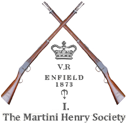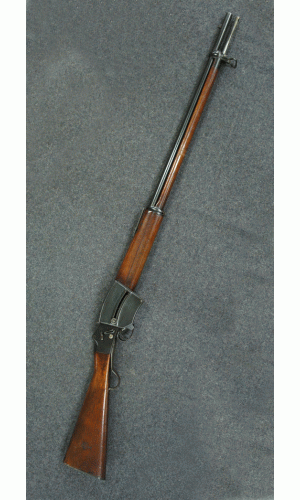Enfield Martini .402" Mk1 Rifle Pattern A
| Approved | 17th April 1886 |
| Calibre | .402 Enfield 7 groove ratchet |
| Length | 4" 1" |
| Weight | 9lb 3oz |
On the 2nd November 1880, the small arms committee had met to consider various potential upgrades for the current MkII. and newly issued MkIII. Martini Henry service rifle. On the 20th January 1881, the committee suggested a new arm for the military, one, which would include the characteristics of the committees report.
Caliber of the rifle was to be .402”, firing a 380 grain 12:1 lead tin alloy bullet.
A new form of ratchet rifling to reduce the fouling characteristics of the Henry rifled barrel
A new form of sliding sight with an allowance for adjustable windage, and a close range “buckhorn” pattern close range. For rapid selection of 100 & 300 yards aiming
A safety catch of half cocking
A quick loader’
An integral wooden hand guard
A new form of receiver and revised stocking to prevent rusting
Comparable weight to the German Mauser, the French Gras and the Werndl.
Enfield Martini pattern A
In 1882, the RSAF presented the experimental arm, designed by Col H J Arbutnot to the Small Arms Committee, whilst also evaluating the exisiting MkIII. Rifle chambered to .402” calibre with 9 groove ratchet rifling. The new experimental arm was a total re-design. Firstly, the stock was re-shaped with a reduced wrist grip and an alteration in the angle of sighting, whilst a new design of receiver, afforded a thumb grip hump across the width of the action, in the trigger guard a button safety catch prevented the firers finger from accessing the trigger. The bayonet band had a Enfield hanging long range sight and a corresponding leaf sight hinged on the left of the action.
By 1884, the design had been overhauled, Instead of the nine grove rifling, Enfield designed a new seven groove reverse ratchet rifling, with the tips of the ratched radiussed over to prevent leading, Most radical development was the omission of the traditional cocking indicator, in favour of a side mounted thumb lever offering a full safety catch by levering the tumbler clear of the trigger sear.
A simple pressed metal magazine which held eight rounds, clipped onto a special morticed bracket screwed onto the right side of the action, and could be stowed away, ready loaded in the valise when not needed but rapidly fixed into place when the need required.
Internal developments of the new design had introduced a new pattern extractor, which was ½” longer on its base, this affected the opening cycle by starting the leverage process earlier in the block depression and providing a more effective extraction of the heavier .402 solid cartridge. The breechblock too had been redesigned, with a slimmer profile and rounded nose to clear the new extractor. On the top of the barrel receiver a fixed 100 yard and a “flip up” 300 yards buckhorn “battle sight” was a notable upgrade, along with an windage adjustable 2000 yard ladder sight, with the hanging sight omitted.
To dissipate barrel heat a wooden hand guard clipped across the barrel, from the middle band to the bayonet band, the barrel was un-supported by the fore-end wood, this prevented moisture collection and enhanced heat dissipation. in September 1885 a small brass shim was installed between the butt plate and this was fastened with two brass screws to prevent the rusting or “freezing” together of the butt plate to the butt. The steel stocking cup was produced in brass too, Finally, the front band carried the first form in British service of bayonet mounting lug installed directly underneath the barrel, It was designated as the Enfield Martini .40” Pattern A. and approved on 17th April 1886. 21,372 were manufactured.






